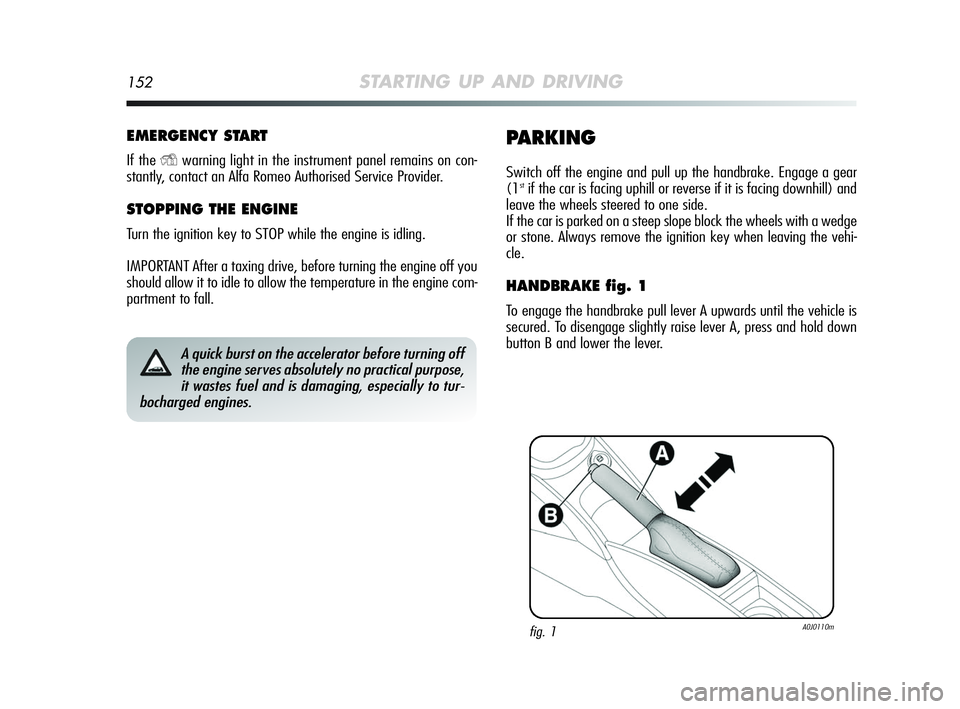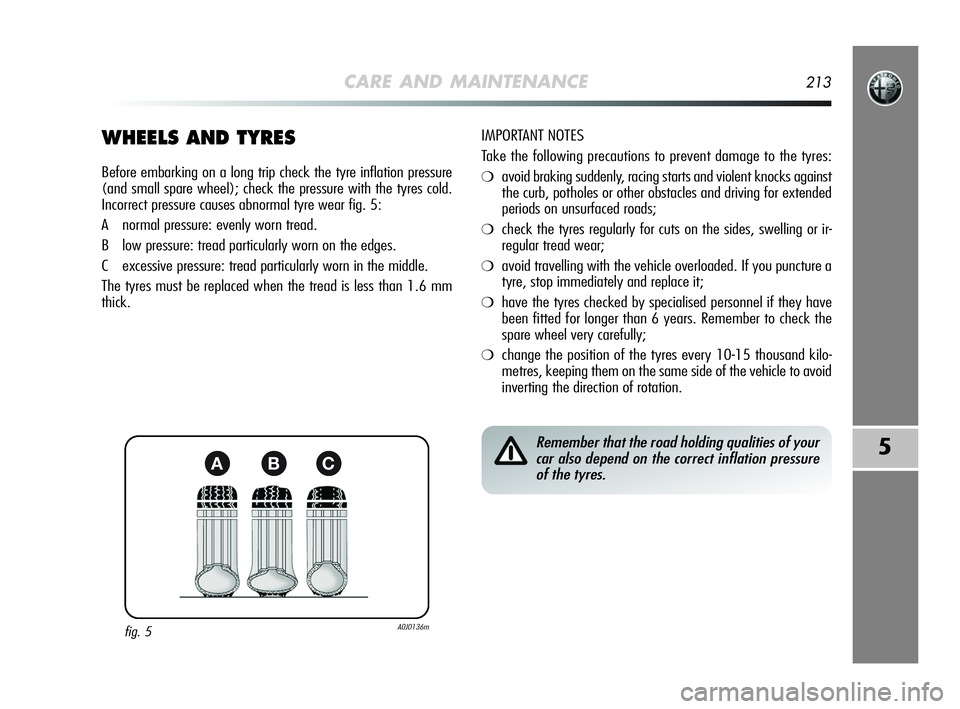stop start Alfa Romeo MiTo 2009 Owner handbook (in English)
[x] Cancel search | Manufacturer: ALFA ROMEO, Model Year: 2009, Model line: MiTo, Model: Alfa Romeo MiTo 2009Pages: 250, PDF Size: 4.61 MB
Page 131 of 250

130SAFETY
The red and green warning lights work as follows:
❍off if the seat belts are already fastened when the ignition is
turned to MAR
❍red if the front seat belts are not fastened
❍flashing red (only those for the rear seats) if the front seat belts
are not fastened
❍green if the seat belts are fastened
When only the driver is present and all the seat belts are unfas-
tened, the first 4 warning lights (fig. 4) come on with a red light
and the last comes on with a green light.
The three central warning lights flash for approximately 30 seconds
and then stay on with a fixed red light.
The two side warning lights A and B-fig. 4 are associated with the
front seats (with left hand drive in this case), while the three cen-
tral warning lights are associated with rear passengers. The warn-
ing lights for the front and rear seats behave in different ways.
Front seats
Driver
If only the driver is present in the car, the situation as described in
fig. 4. Once the car exceeds 20 km/h or remains at a speed be-
tween 10 km/h and 20 km/h for a time greater than 5 seconds,
an acoustic warning cycle begins for the front seats (continuous
acoustic signal for the first 6 seconds followed by an additional
90 second beep) and flashing of the warning light. Once the cy-
cle is complete, the warning lights remain on with a fixed light
until the car is turned off. The acoustic signal stops immediately
when the driver’s seat belt is fastened and the warning light changes
to green. If the seatbelt is unfastened again while the vehicle is in motion,
the acoustic signal and the warning light flashing are resumed as
described previously
Passenger
A similar situation arises for the front passenger, except that the
warning lights becomes green and the signal also stops when the
passenger leaves the car. In the event that both front seat belts are
unfastened with the vehicle in motion, a few seconds apart, the
acoustic signal refers to the most recent event, while both warning
lights display a visual signal independently of one another.
Rear seats
A signal is only produced for the rear seats when any one of the
belts is unfastened . Under these conditions, the warning light for
the unfastened belt begins to flash for a duration of 30 seconds.
An acoustic signal is also emitted. If more than one belt is unfas-
tened, the visual signal begins and ends independently for each
warning light.
IMPORTANT
All the warning lights stay on if at least one of the front seats is
occupied with the belt unfastened.
All the warning lights go off (30 seconds after the last seat belt is
fast and) when all front seats are occupied, irrespective of the
status of the rear belts.
All the warning lights come on when at least one of the belts
changes from fastened to unfastened or vice versa.
All the warning lights stay off if all the seat belts have already been
fastened when the car is started.
127-148 Alfa MiTo GB 12-11-2008 15:41 Pagina 130
Page 151 of 250

150STARTING UP AND DRIVING
STARTING THE ENGINE
STARTING PROCEDURE FOR PETROL VERSIONS
Proceed as follows:
❍engage the handbrake and place the gearbox in neutral;
❍press the clutch pedal down to the floor without touching the
accelerator;
❍turn the ignition key to AVV and let it go the moment the en-
gine starts.
IMPORTANT NOTES
❍If the engine does not start on the first attempt, turn the igni-
tion key to STOP before repeating the operation.
❍If, when the ignition key is on MAR, the Ywarning light (or
symbol in the display) remains lit together with the
Uwarn-
ing light, turn the key to STOP and then back to MAR; if the
warning light remains on, try using the other keys provided
with the car. If you are still unable to start the engine carry
out the emergency starting procedure (see “Emergency Start-
up” in chapter 4) and contact an Alfa Romeo Authorised Ser-
vice Provider.
❍Never leave the ignition key on MAR when the engine is off.
PROCEDURE FOR DIESEL VERSIONS
Proceed as follows:
❍engage the handbrake and place the gearbox in neutral;
❍turn the ignition key to MAR: the mandYwarning lights
(or symbol in the display) will come on;
❍wait for the warning light (or symbol in the display) to go
out;
❍press the clutch pedal down to the floor without touching the
accelerator;
❍turn the ignition key to AVV as soon as the mwarning light
goes out. Waiting too long will waste the work done by the
glow plugs. Release the key as soon as the engine starts.
If warning light mblinks for 60 seconds after
starting or during prolonged cranking, this indi-
cates a fault in the glow plug pre-heating system.
Use the car normally if the engine starts and contact an
Alfa Romeo Authorised Services provider as soon as pos-
sible.
149-158 Alfa MiTo GB 12-11-2008 15:41 Pagina 150
Page 153 of 250

152STARTING UP AND DRIVING
EMERGENCY START
If the Ywarning light in the instrument panel remains on con-
stantly, contact an Alfa Romeo Authorised Service Provider.
STOPPING THE ENGINE
Turn the ignition key to STOP while the engine is idling.
IMPORTANT After a taxing drive, before turning the engine off you
should allow it to idle to allow the temperature in the engine com-
partment to fall.
PARKING
Switch off the engine and pull up the handbrake. Engage a gear
(1stif the car is facing uphill or reverse if it is facing downhill) and
leave the wheels steered to one side.
If the car is parked on a steep slope block the wheels with a wedge
or stone. Always remove the ignition key when leaving the vehi-
cle.
HANDBRAKE fig. 1
To engage the handbrake pull lever A upwards until the vehicle is
secured. To disengage slightly raise lever A, press and hold down
button B and lower the lever.
A quick burst on the accelerator before turning off
the engine serves absolutely no practical purpose,
it wastes fuel and is damaging, especially to tur-
bocharged engines.
fig. 1A0J0110m
149-158 Alfa MiTo GB 12-11-2008 15:41 Pagina 152
Page 156 of 250

STARTING UP AND DRIVING155
3
Electric devices
Use electric devices only for the amount of time needed. The heat-
ed rear windscreen, additional headlights, windscreen wipers and
heater fan require a considerable amount of energy; increasing the
current uptake increases fuel consumption (by up to +25% in an
urban cycle).
Climate control
Using the climate control system increases fuel consumption: use
the air vents when outdoor temperature permits.
Spoilers
The use of non-certified spoilers may adversely affect air drag and
fuel consumption.
DRIVING STYLE
Starting
Do not warm the engine up with the car at a standstill and do not
use excessive engine speeds: the engine warms up very slowly in
these conditions, increasing fuel consumption and emissions. It is
advisable to start off immediately and slowly, keeping the engine
speed down: the engine will warm up much faster this way.
Unnecessar y actions
Avoid revving up when starting at traffic lights or before stopping
the engine. The latter action, like double-declutching, is unneces-
sary and causes increased fuel consumption and pollution.
Gear selection
When traffic and road conditions allow, use a high gear. Using a
low gear for faster acceleration will increase fuel consumption. In
the same way improper use of a high gear increases consump-
tion, emissions and engine wear.
Top speed
Fuel consumption considerably increases as speed increases. Keep
your speed as even as possible, avoiding unnecessary braking
and acceleration which cause excessive fuel consumption and in-
creased emissions.
Acceleration
Sudden acceleration has a very negative effect on fuel consump-
tion and emissions: accelerate gradually and do not go over the
maximum torque ratio.
149-158 Alfa MiTo GB 12-11-2008 15:41 Pagina 155
Page 214 of 250

CARE AND MAINTENANCE213
5
WHEELS AND TYRES
Before embarking on a long trip check the tyre inflation pressure
(and small spare wheel); check the pressure with the tyres cold.
Incorrect pressure causes abnormal tyre wear fig. 5:
A normal pressure: evenly worn tread.
B low pressure: tread particularly worn on the edges.
C excessive pressure: tread particularly worn in the middle.
The tyres must be replaced when the tread is less than 1.6 mm
thick.IMPORTANT NOTES
Take the following precautions to prevent damage to the tyres:❍avoid braking suddenly, racing starts and violent knocks against
the curb, potholes or other obstacles and driving for extended
periods on unsurfaced roads;
❍check the tyres regularly for cuts on the sides, swelling or ir-
regular tread wear;
❍avoid travelling with the vehicle overloaded. If you puncture a
tyre, stop immediately and replace it;
❍have the tyres checked by specialised personnel if they have
been fitted for longer than 6 years. Remember to check the
spare wheel very carefully;
❍change the position of the tyres every 10-15 thousand kilo-
metres, keeping them on the same side of the vehicle to avoid
inverting the direction of rotation.
fig. 5A0J0136m
ABC
Remember that the road holding qualities of your
car also depend on the correct inflation pressure
of the tyres.
197-220 Alfa MiTo GB 12-11-2008 15:42 Pagina 213